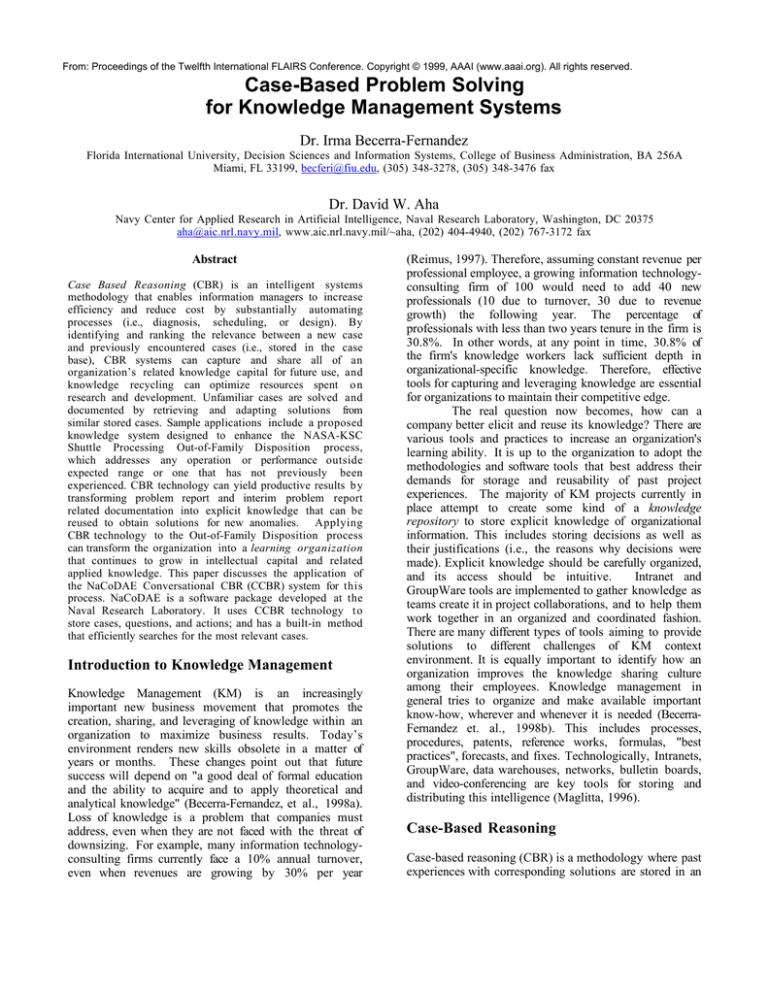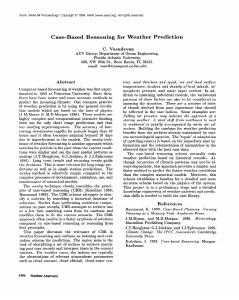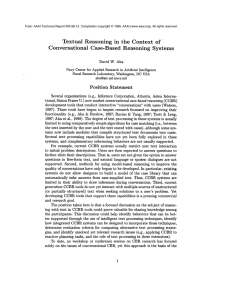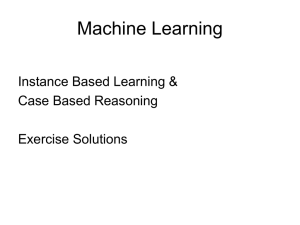
From: Proceedings of the Twelfth International FLAIRS Conference. Copyright © 1999, AAAI (www.aaai.org). All rights reserved.
Case-Based Problem Solving
for Knowledge Management Systems
Dr. Irma Becerra-Fernandez
Florida International University, Decision Sciences and Information Systems, College of Business Administration, BA 256A
Miami, FL 33199, becferi@fiu.edu, (305) 348-3278, (305) 348-3476 fax
Dr. David W. Aha
Navy Center for Applied Research in Artificial Intelligence, Naval Research Laboratory, Washington, DC 20375
aha@aic.nrl.navy.mil, www.aic.nrl.navy.mil/~aha, (202) 404-4940, (202) 767-3172 fax
Abstract
Case Based Reasoning (CBR) is an intelligent systems
methodology that enables information managers to increase
efficiency and reduce cost by substantially automating
processes (i.e., diagnosis, scheduling, or design). By
identifying and ranking the relevance between a new case
and previously encountered cases (i.e., stored in the case
base), CBR systems can capture and share all of an
organizationÕs related knowledge capital for future use, and
knowledge recycling can optimize resources spent o n
research and development. Unfamiliar cases are solved and
documented by retrieving and adapting solutions from
similar stored cases. Sample applications include a proposed
knowledge system designed to enhance the NASA-KSC
Shuttle Processing Out-of-Family Disposition process,
which addresses any operation or performance outside
expected range or one that has not previously been
experienced. CBR technology can yield productive results b y
transforming problem report and interim problem report
related documentation into explicit knowledge that can be
reused to obtain solutions for new anomalies. Applying
CBR technology to the Out-of-Family Disposition process
can transform the organization into a learning organization
that continues to grow in intellectual capital and related
applied knowledge. This paper discusses the application of
the NaCoDAE Conversational CBR (CCBR) system for this
process. NaCoDAE is a software package developed at the
Naval Research Laboratory. It uses CCBR technology t o
store cases, questions, and actions; and has a built-in method
that efficiently searches for the most relevant cases.
Introduction to Knowledge Management
Knowledge Management (KM) is an increasingly
important new business movement that promotes the
creation, sharing, and leveraging of knowledge within an
organization to maximize business results. TodayÕs
environment renders new skills obsolete in a matter of
years or months. These changes point out that future
success will depend on "a good deal of formal education
and the ability to acquire and to apply theoretical and
analytical knowledge" (Becerra-Fernandez, et al., 1998a).
Loss of knowledge is a problem that companies must
address, even when they are not faced with the threat of
downsizing. For example, many information technologyconsulting firms currently face a 10% annual turnover,
even when revenues are growing by 30% per year
(Reimus, 1997). Therefore, assuming constant revenue per
professional employee, a growing information technologyconsulting firm of 100 would need to add 40 new
professionals (10 due to turnover, 30 due to revenue
growth) the following year. The percentage of
professionals with less than two years tenure in the firm is
30.8%. In other words, at any point in time, 30.8% of
the firm's knowledge workers lack sufficient depth in
organizational-specific knowledge. Therefore, effective
tools for capturing and leveraging knowledge are essential
for organizations to maintain their competitive edge.
The real question now becomes, how can a
company better elicit and reuse its knowledge? There are
various tools and practices to increase an organization's
learning ability. It is up to the organization to adopt the
methodologies and software tools that best address their
demands for storage and reusability of past project
experiences. The majority of KM projects currently in
place attempt to create some kind of a knowledge
repository to store explicit knowledge of organizational
information. This includes storing decisions as well as
their justifications (i.e., the reasons why decisions were
made). Explicit knowledge should be carefully organized,
and its access should be intuitive.
Intranet and
GroupWare tools are implemented to gather knowledge as
teams create it in project collaborations, and to help them
work together in an organized and coordinated fashion.
There are many different types of tools aiming to provide
solutions to different challenges of KM context
environment. It is equally important to identify how an
organization improves the knowledge sharing culture
among their employees. Knowledge management in
general tries to organize and make available important
know-how, wherever and whenever it is needed (BecerraFernandez et. al., 1998b). This includes processes,
procedures, patents, reference works, formulas, "best
practices", forecasts, and fixes. Technologically, Intranets,
GroupWare, data warehouses, networks, bulletin boards,
and video-conferencing are key tools for storing and
distributing this intelligence (Maglitta, 1996).
Case-Based Reasoning
Case-based reasoning (CBR) is a methodology where past
experiences with corresponding solutions are stored in an
electronic database of cases (i.e., a case base or case
library) for quick and effective retrieval (Aamodt & Plaza,
1994). CBR has performed well on some KM tasks;
Davenport and Prusak (1998) note that ÒCase-based
reasoning programs have been shown to bring about
marked improvements in customer service.Ó It does this
by mimicking the way humans use their experience to
solve problems. CBR emulates human problem solving
by retrieving relevant cases (<problem,solution>
experiences) from the case base. Relevant cases are those
whose problems are similar to the current problem; their
solutions typically require adaptation.
CBR is also an expert systems approach that is a
popular alternative to rule-base architectures. Although it
may be difficult for experts to explain their decision rules,
they are often able and willing to tell war stories about
their experiences, which facilitates the development of a
case base and its indexing scheme.
CBR systems input a problem description from
the user, compute its similarity with the problems in the
case library, and retrieve solutions from the cases whose
problems are most similar. Cases that capture problemsolving experiences or lessons learned are organized in a
structured case base and indexed so that they can be easily
retrieved and adapted to solve new problems. A system of
this kind can prevent recurrences of mistakes and
repetition of work.
There are several advantages to using CBR. In
domains that lack a strong domain theory, model based
reasoning is not practical. When the relationship between
the case attributes and the solution or outcome is not
understood well enough to represent it in rules, or when
the ratio of cases that are "exceptions to the rule" is high,
rule based systems become impractical. CBR is especially
useful in such situations because it models the exceptions
and the novel cases (Morris, 1995). Often a solution can
be derived from the combination of more than one case.
These solutions are modified and combined to provide a
solution of a newly entered case. It is here where methods
for adaptation are used, providing the user with steps to
combine and derive a solution from the collection of
retrieved solutions.
NRL: Extending the Case-Based Reasoning
Concept
The Navy Center for Applied Research in Artificial
Intelligence (NCARAI) has been involved in both basic
and applied research in artificial intelligence since its
inception in 1982. NCARAI, part of the Information
Technology Division within the Naval Research
Laboratory, is engaged in research and in development
efforts designed to address the application of artificial
intelligence technology and techniques to critical Navy
and national problems. NCARAIÕs NaCoDAE1 (Navy
Conversational Decision Aids Environment) tool was
1
www.aic.nrl.navy.mil/~aha/cbr/nacodae.html
designed to minimize the loss of organizational
knowledge, efficiently use lessons learned databases, and
foster the creation of CBR applications for solving Navy
and other DoD problems (Breslow & Aha, 1998).
Several NCARAI projects have focused on designing,
implementing, and evaluating practical extensions of
NaCoDAE. This software, intended to aid Navy and other
DoD personnel in decision aid tasks, is based on
conversational CBR (CCBR) technology, as explained
below. NaCoDAE has the advantage that it is free and
publicly available, and because it was developed in Java it
can be adapted to execute on the WWW, freeing the
distribution of knowledge from geographical constraints.
Originally based on Inference CorporationÕs CBR
products, which were used to implement NASA-GSFCÕs
RECALL application (see Section 4), NaCoDAE has been
extended to simplify case authoring tasks (Aha &
Breslow, 1997) and to address distributed crisis response
planning tasks (Aha et al., 1998b).
CCBR tools have been specifically designed to solve
interactive KM tasks, and our focus will be on using
NaCoDAE.
Each case in NaCoDAE has three
components:
1. The description summarizes, in natural language
text, the experience/lesson.
2. The state contains a set of <question, answer>
pairs that are used to guide a user to the closest
matching lesson. These pairs characterize the
lessonÕs context. A caseÕs description and state
together define the problem it addresses.
3. The solution provides a recommendation for others
confronted with a similar situation.
The outcome of applying a caseÕs solution to a caseÕs
problem is assumed to be acceptable (i.e., all cases
capture positive experiences), although negative
experiences can also be accommodated.
CCBR problem-solving behavior can be exemplified
by considering a lessons-learned application. When users
encounter new problems, they enter the characteristics of
the new situation as a query. Initially, a user enters a
textual description of their problem. NaCoDAE responds
by computing the similarity of this description with the
stored descriptions of each case. It then displays the most
similar case solutions to the user, along with questions
from their respective states. These questions provide a
focus of attention; the user can answer any of them to
refine their query. In response, NaCoDAE re-computes
similarities (i.e., by comparing the caseÕs states with the
queryÕs <question, answer> pairs), which updates the case
and question displays. Thus, solutions (lessons) to
problems that closely match the query are displayed,
which allows users to retrieve relevant related lessons. If
some of the displayed lessons have a high similarity to
the query, then they may provide insight on how to solve
the query, and can be selected by the user to reapply in
some new way. Users can create new cases by revising
retrieved solutions so that they are applicable to the new
situation. These new cases, which reflect what has been
learned through experience, can be submitted for addition
to the case base. In this way, the system can learn as its
users learn.
Although a CCBR case base could be developed
incrementally over time as users uncover new lessons and
solve new problems, most case bases are not developed
incrementally. Instead, cases are typically authored in a
systematic software engineering process designed to
ensure good problem-solving coverage and minimize
conflicts. This process reduces concerns that end-users
might create new cases that significantly deteriorate
overall system performance.
Several challenges exist with producing CCBR
case libraries that guarantee good retrieval performance.
First, it is easy to construct a case library but often
difficult to engineer one that performs well. NaCoDAEÕs
research focuses on simplifying the case-authoring task to
ensure high retrieval precision and efficiency (Aha &
Breslow, 1997; Aha et al., 1998a). Second, system
validation remains an important issue; the extent to which
the case base covers the domain must be assessed (Smyth
& McKenna, 1998). Third, care must be taken to ensure
that the system knows its limitations. This can be
partially addressed by using learning techniques to tune
the systemÕs similarity function. Still, if the case base
does not have a sufficiently similar case, the recalled
solution may be inappropriate. To prevent recalling
inappropriate cases, the system should warn the user that
no similar cases have been found in the case base. Morris
(1995) suggests that Òthe case database should be
designed to include both examples where the proposed
solutions succeeded and where they failed.Ó However, it is
not always necessary to include both types of examples,
provided that the set of ÒpositiveÓ cases suffices for the
intended appropriation. For example,
Inference
Corporation, a commercial CCBR tool vendor uses only
positive cases in its help-desk applications.
NaCoDAE was integrated with the fast queryretrieval system Parka-DB, which was developed at the
University of Maryland (Hendler et al., 1996). This
integration enhanced NaCoDAEÕs dialogue capabilities.
In particular, it could previously not derive inferences
from a partially constructed query. In this integration,
NaCoDAE passes its query to Parka-DB as a set of
relational assertions that constitutes a knowledge base.
Given a model of the case library, which must be
constructed by the case author, Parka-DB can then find
questions that have only been implicitly answered by the
queryÕs current contents. It returns all such answers to
NaCoDAE, which are then immediately incorporated into
the query. In this way, users can retrieve solutions by
answering fewer questions, on average, which improves
retrieval efficiency (Aha et al., 1998a).
NaCoDAE's development team created a
Cooperative Research and Development Agreement with
Inference Corporation on the topic of evaluating potential
extensions of their CBR products. Topics being pursued
include investigations on integrating conversational CBR
approaches with model-based approaches, featured
selection, and on other tasks related to CCBR. We
describe an application of NaCoDAE in Section 5.
NASA Goddard Space Flight Center:
Managing Lessons Learned using CaseBased Reasoning
NASA has over the years enjoyed the advantage of having
a very stable workforce. Unfortunately, recent pressures to
downsize are causing the organization to suffer depletion
in its knowledge base. This phenomena, coupled with the
need to minimize repetition of work has generated a need
for the creation of NASAÕs Lessons Learned Information
System (LLIS). Its purpose is to collect and make
available the lessons learned from the aeronautics and
space activities derived from almost forty years of
experience. Those who may benefit from the experiences
of others will use these lessons. Both government and
industry have long recognized the need to document and
apply the knowledge gained from past experience to
current and future projects, in order to avoid repeating of
past failures and mishaps. Through this system, NASA
seeks to facilitate the early incorporation of safety,
reliability, maintainability, and quality into the design of
flight and ground support hardware, software, facilities,
and procedures.
NASA-GSFC needed a way to automate the
access to the lessons learned repository so that it could be
used more efficiently. The organization needed a way to
stop recurrence of problems, encourage implementation of
best practices, and reduce operation costs by minimizing
the number of meetings and increase communication and
collaboration between teams. GFSC decided to
implement their LLIS system in a prototype to capture
and reuse the lessons learned using CBR, implemented in
the RECALL (R eusable Experience with Case-Based
Reasoning for Automating Lessons Learned) system.2
Systems and software engineering lessons learned on
projects were primarily captured, although other relevant
lessons could also be incorporated. CBR provided an
alternative approach to more traditional information access
mechanisms, such as database query schemes and
keyword searching. Furthermore, it gave the organization
a way to minimize recurrence of problems, and as a result
costs were reduced.
An operational prototype of
RECALL
can
be
found
at
http://hope.gsfc.nasa.gov/RECALL.
2
http://llis.gsfc.nasa.gov
NASA-KSC: Solving Problems Using
Conversational Case-Based-Reasoning in
the Out-of-Family Disposition Process
When the domain theory is weak, it is difficult to justify
or explain a position based on first principles. Drawing
the analogy to similar solutions helps assess unfamiliar
cases.
In the Out-of-Family Disposition process,
unfamiliar cases are referenced to be solved and
documented. Thus this process lends itself to the
adoption of a system capable of capturing all knowledge
for future use. The Out-of- Family Disposition process
was created to provide information on any operation or
performance outside expected range or which has not been
previously experienced. Among all the anomaly
dispositions the following are considered to be Out-ofFamily:
1. Material Review Board (MRB) anomalies
2. (OMRSD) waivers/exceptions
3. Unexplained anomalies
Thus, adopting technologies that can maximize the
benefits obtained from the Out-of-Family disposition
knowledge base can be used throughout the entire
organization.
CBR technology can enhance the Out-of-Family
Disposition process by documenting unfamiliar troubles
in a way that make the solutions to these cases available
to the rest of the organization. As more unfamiliar cases
get documented within the CBR system, the
organizationÕs knowledge capital asset will increase, and
the solutions for all cases will be made available to the
rest of the organization. Therefore, a CBR application for
this task can potentially transform NASA into a Òlearning
organizationÓ that continues to grow in intellectual capital
and related applicable knowledge that can benefit the
entire organization.
The Out-of-Family Disposition process is also
confronted with organizational difficulties in the areas of
information management, knowledge
dissipation,
knowledge retrieval, and applications of its knowledge
capital. For these reasons, this process is an ideal initial
target for the application of CCBR technology. A CCBR
prototype would support:
1. knowledge capture, since CCBR would be used to
process all information,
2. the gathering of relevant documentation and data and
converting it into reusable knowledge,
3. ease of access, so organizational knowledge can be
made applicable to new projects, and
4. a centralized repository of related documentation, for
example within the lessons learned repository,
Organizations with significant intellectual capital (e.g.,
NASA) must elicit and capture knowledge for later use to
effectively utilize organizational resources. By reusing
previously acquired knowledge the organization can save
time and capital. To catalog organizational knowledge for
reuse, appropriate tools must be developed. CCBR
technology can improve the decision-making by
identifying scenarios previously encountered and by
adapting the previous experiences to the current problem
scenario, in order to provide a solution. CCBR systems
can combine cases if their problems are similar to the
current query.
Conclusion
Organizations with significant intellectual capital, such as
NASA and the Navy, require eliciting and capturing
knowledge for later reuse in order to effectively utilize
organizational resources. By reusing previously acquired
knowledge, an organization can achieve savings in time
and capital. In order to catalog organizational knowledge
for reuse, appropriate tools must be developed.
NCARAIÕs NaCoDAE tool is designed to minimize the
loss of organizational knowledge, efficiently use lessons
learned databases, foster the creation of CBR applications,
and to apply them to KM problems, particularly in
decision aid tasks. NaCoDAE is based on conversational
CBR (CCBR) technology.
CCBR tools enhance
decision making by identifying similar scenarios
previously encountered and by adapting the previous
experiences to the current problem scenario, in order to
provide a new solution. A CCBR system can combine
cases if they have similar patterns to that of the current
case. In addition, this technology can serve as a learning
tool that makes use of all documented experience from
past projects and applies it to a present project
application. The implementation of CCBR technology
has the potential of transforming the decision making
process into a continuous learning system. CCBR does
this by incorporating, interpreting and storing present
projects in the case base as they're solved, to reuse at a
later date or when a similar case scenario is encountered.
CCBR technology is ideal for the implementing
a lessons- learned repository; it can apply the stored
information to future cases. CCBR can generate a new
solution that best fits the current conditions, making use
of previous lessons learned.
In general, a CCBR
systemÕs performance will increase with its case library
size, and thus its ability to provide more accurate
solutions. The more information contained within the
case base, the richer the combination of patterns and the
wider the range of choices from which CCBR can
combine and generate a solution.
Acknowledgements
The Authors wish to acknowledge NASA-KSC and
Florida Space Grant Consortium, for financial support to
this project, entitled "NASA-KSC/FSGC Program
Corporate Memory: Knowledge Repository for Kennedy
Space CenterÓ, Grant number NAG10-0232; as well as the
following NASA-KSC employees who contributed with
their insights to this research: Loren Shriver, James
Jennings, Gregg Buckingham, Robert B. Sieck, Timothy
S. Barth, Arthur E. Beller, Timothy J. Greer, William C.
Higgins, Suzanne E. Hilding, Jerrace C. Mack, Peter P.
Nickolenko, Ronald L. Phelps, Stephen C. Robling,
James G. Tatum, Launa M. Maier; and Harold Gubnitsky
of Cambridge Technology Partners. This research was
also sponsored in part by the Office of Naval Research and
Inference Corporation.
The authors also wish to
acknowledge the collaboration of the students at the
Knowledge Management Lab at Florida International
University, in particular Andres De La Serna.
References
Aamodt, A., & Plaza, E. (1994). Case-based reasoning:
Foundational issues, methodological variations, and
system approaches. AI Communications, 7(1), 39-52.
Aha, D. W., & Breslow, L. A. (1997). Refining
conversational case libraries. Proceedings of the
Second International Conference in Case-Based
Reasoning (pp.267-278). Providence, RI: SpringerVerlag.
Aha, D. W., Maney, T., & Breslow, L. A. (1998a).
Supporting dialogue inferencing in conversational
case-based reasoning. Fourth European Workshop on
Case-Based Reasoning (pp. 262-273). Dublin,
Ireland: Springer
Aha, D. W., Breslow, L. A., & Maney, T. (1998b).
Supporting conversational case-based reasoning in an
integrated reasoning framework. In D.W. Aha & J.J.
Daniels (Eds.) Case-Based Reasoning Integrations:
Papers from the 1998 Workshop (Technical Report
WS-98-15). Madison, WI: AAAI Press.
Becerra-Fernandez, I., Riedel, J., & Lee, T. (1998a,
February). Knowledge Management: Redefining
Corporate Assets.
Proceedings of the 7th
International Conference on Management of
Technology Conference. Orlando, Florida.
Becerra-Fernandez, I. (1998b, April). Center for
Innovation and Knowledge Management. Association
for Computer Machinery SIGGROUP Bulletin,
special
Issue
on
Knowledge
Management
"Knowledge Management at Work", 19 (1), 46-51.
Breslow, L. A. & Aha, D. W. (1998). NaCoDAE: Navy
Conversational
Decision
Aids
Environment
(Technical Report AIC-97-018).
NCARAI,
Washington, DC.
Davenport, T.H., & Prusak, L. (1998). Working
Knowledge: How Organizations Manage What they
Know. Boston, MA: Harvard Business School Press.
Maglitta, J. (1996, January). Know-how, Inc.: once a
conference curiosity, knowledge management is
catching on. Computerworld, pp. 73-75.
Morris, B. Ph.D. (1995), Case-Based Reasoning, West
Virginia University. See www.bus.orst.edu under
/faculty/brownc/AIES/news-let/fall95/casebase.htm.
Reimus, B. (1997). Knowledge Sharing within
Management Consulting Firms. Fitswilliam, NH:
Kennedy Publications.
Smyth, B. & McKenna, E. (1998). Modelling the
competence of case bases. Fourth European
Workshop on Case-Based Reasoning (pp. 208-220).
Dublin, Ireland: Springer.






